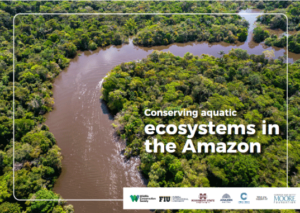CONSERVATION TARGETS: CONSERVING AQUATIC ECOSYSTEMS IN THE AMAZON
Human life, culture and livelihoods in the Amazon are intimately linked to the aquatic ecosystems that exist in the Amazon Basin. Rivers provide indispensable ecosystem services to the inhabitants of urban and rural areas; they act as communication routes in the territory, and the floods produced by their waters at certain times of the year enrich the agricultural areas. The streams and lakes in their basins are home to fish that provide part of the protein and income that Amazonian populations need to subsist.
25 Amazon experts identified large-scale conservation targets for aquatic ecosystems in the Amazon Basin.
1. Conserve of the Western Amazon connected riverscapes to maintain Andean influences and protect biocultural diversity.
2. Maintain biodiverse and functional floodplains that provide critical ecosystem services.
3. Sustain freshwater commercial fish and fisheriesto support biodiversity and human wellbeing.
We conserve through them
- The rivers that are born in the Andes, and their contributions of nutrients, sediments, and organic matter to the lowland Amazon.
- The Amazon floodplains, which are one of the most biodiverse and productive ecosystems on Earth.
- The migratory Amazonian fish species and the connectivity of their local or continental journeys.
- The commercial fisheries dependent on fish migrations.
- The livelihoods and sustenance of Amazonian inhabitants.
- And more!
READ THE FULL REPORT
Conserving aquatic
ecosystems in the Amazon
In addition, from this Zotero library you will be able to review the list of bibliographic references that was used for the investigation of the Conservation Targets in the Amazon Basin.
There are more than 300 references for consultation. Click below to review them:

Conservation Target: Conserve connected riverscapes of the Western Amazon to maintain Andean influences and protect biocultural diversity.
The Western Amazon is the region encompassed by the basins of all Andean-origin rivers that drain toward the mainstem Amazon. These river basins are characterized by strong elevational and climatic gradients, and contain an array of unique habitats. The Western Amazon as a region, and specifically the slopes of the Andes, harbor biological diversity unparalleled by other places on Earth.
This target recognizes the importance of conserving the rivers of the Western Amazon because of their influence on the ecosystems of the Amazon basin in general.
The area of the Andean origin river basins above 500 m is only about 13% of the Amazon Basin, but the contributions of sediments and nutrients from this area are disproportionate to its relatively small size. The region is also known as a global center of biodiversity, with high species richness and endemism across plants, birds, small mammals, amphibians, and fishes. Aquatic ecosystems are essential in harboring this biodiversity.
Rivers of the Western Amazon offer critical migration corridors for fish species that move from the lowlands into the Andean piedmont and foothills for spawning.
Rivers in the Western Amazon also influence culture and livelihoods of the people who live in the region. Rivers and freshwater biota are prominent in the cosmologies of several Indigenous groups and daily life of riparian human communities is tightly adapted to the rhythmic nature of river flows.
Factors that fragment rivers and decrease longitudinal connectivity can disrupt these myriad social and ecological processes. Therefore, monitoring the construction of dams and roads and their impact on biodiversity in the region is critical to achieve this conservation target.
Conservation Target: Maintain biodiverse and functional floodplains that provide critical ecosystem services que proveen
Floodplains in the Amazon are some of the most biologically diverse and productive ecosystems on Earth, providing a wide variety of economic and cultural services. However, they are under pressure from stressors that could push them to a tipping point, where ecosystem could reach a transformed and irreversible state.
As ecosystems approach critical thresholds, features are observed that serve as early warning signals. Detection of these signals can help predict future drastic changes.
The working group identified climate change, deforestation and the construction of hydroelectric dams as factors capable of altering the hydrological regime, disrupting the flood pulse and reducing lateral connectivity of rivers with the floodplain.
Achieving this target depends maintaining three attributes of the flood pulse regime —predictability, duration, and magnitude— together with ensuring the persistence of floodplain forests, which support both aquatic and terrestrial plants and animals, and numerous ecosystem services.
Floodplain forests are a key aquatic ecosystem and can serve as sentinels to understand the responses of environmental change in the Amazon.
Conservation Target: Sustain freshwater commercial fish and fisheries to support biodiversity and human well-being.
Migratory species are the most important fish captured in the commercial fisheries of the Amazon. However, there are ominous indications of the collapse of several important migratory fish species, especially of iconic long-distance migrants.
If overfishing of long-distance migratory species is not controlled, then there will be little incentive to protect other migratory species and their wetland habitats, and thus fisheries in general. The elimination of these long-distance migratory species would represent a tipping point not only for Amazon fisheries, but also for aquatic biodiversity.
Management of long-distance migratory fish species can only be effectively and realistically addressed at the regional level through integrated and centralized government actions that monitor and evaluate fish stocks, implement fisheries regulations, mitigate the impacts of dams, and preserve the wetlands that fish depend upon.
Recommendations to acheive this conservation target include:
- Unite urban and rural fishery management;
- Reinstate government responsibility to collect urban fishery market data;
- Reduce fishing effort through enforced market regulations;
- Eliminate fishing subsidies;
- Foster interstate and international fishery agreements;
- Mitigate impacts of the Madeira dams;
- Monitor deforestation in floodplains; y
- Monitor ecosystem level impacts of overfishing.
DEVELOPED MAPS IN THE FRAMEWORK OF THE CONSERVATION TARGETS FOR THE AMAZON




































